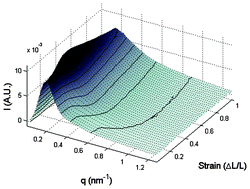Ultra high molecular weight polyethylene (UHMWPE), of the types used in orthopaedic implants, has been irradiated in air and in nitrogen to give received doses between zero and ten Mrad and has been subject to tensile testing whilst simultaneously recording the wide angle and small angle X-ray scattering (WAXS and SAXS) diffraction patterns, using the synchrotron facilities at Diamond. Commercial implant grade polymer, which has been subject to irradiation and two different thermal annealing or stabilising processes, to prevent age related embrittlement, has also been examined. With all materials, as the sample elongates lamellae reorganisation processes occur at a strain of around 0.1, as the unit cell converts from orthorhombic to monoclinic, and yield commences. Yield in the irradiated polymers is associated with a pronounced peak in the stress–strain curve, whereas yield in unirradiated, and in thermally annealed polymers, does not involve a peak in the stress curve. SAX plots show that lamellae reorganisation, during yield, occurs much faster in irradiated materials. This lamellae reorganisation is thought to involve a slip and glide initiated unravelling of the folds, accompanied by refolding and reorientation of parts of existing lamellae. It is proposed that in irradiated materials this is facilitated by nucleation sites on the surface of the lamellae, resulting from radiation damage. The total crystallinity increases slightly during the yielding process and it is thought that this crystal growth involves an interfacial all-trans amorphous phase previously identified with these materials. The greatest effects arise when the samples are irradiated in air. This suggests that the stabilising processes, involving annealing of irradiated polymers, probably work through restoring crystal perfection, as well as increasing the network density in the amorphous phase. Taken in conjunction with existing knowledge on free radical quenching, the information generated allows a much greater understanding of the steps necessary to produce a stable implant grade UHMWPE. It is well known that premature failure of hard metal on polyethylene joint systems causes much discomfort and difficult revision surgery. In recent years irradiated and annealed polymers have taken over much of the market, but the mechanism of action of the annealing processes is only partially understood. Free radical quenching is clearly part of the story, but is not in itself sufficient to explain why irradiated and heat treated polymers perform much better than those simply irradiated under nitrogen. This paper proposes that the heat treatment processes are important in restoring crystal perfection after radiation damage. Irradiation inserts nucleation sites for crystal slip and glide, which occurs when the polymer is strained, but annealing at temperatures close to Tm, restores perfection. This is shown through simultaneous SAXS and WAXS analysis whilst the sample is being strained in the X-ray beam.


 Please wait while we load your content...
Please wait while we load your content...